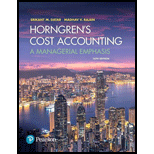
Horngren's Cost Accounting: A Managerial Emphasis (16th Edition)
16th Edition
ISBN: 9780134475585
Author: Srikant M. Datar, Madhav V. Rajan
Publisher: PEARSON
expand_more
expand_more
format_list_bulleted
Question
Chapter 12, Problem 12.15Q
To determine
To explain: Measuring partial productivity would be of any use or not if the total productivity has already been analyzed.
Expert Solution & Answer
Want to see the full answer?
Check out a sample textbook solution
Students have asked these similar questions
Please provide the correct answer to this financial accounting problem using valid calculations.
Calculate o's net sales for this period
What is the net income? Accounting question
Chapter 12 Solutions
Horngren's Cost Accounting: A Managerial Emphasis (16th Edition)
Ch. 12 - Define strategy.Ch. 12 - Describe the five key forces to consider when...Ch. 12 - Prob. 12.3QCh. 12 - What is a customer preference map, and why is it...Ch. 12 - Prob. 12.5QCh. 12 - What are four key perspectives in the balanced...Ch. 12 - What are the five types of conditions to consider...Ch. 12 - Describe three features of a good balanced...Ch. 12 - What are three important pitfalls to avoid when...Ch. 12 - Describe three key components in doing a strategic...
Ch. 12 - Why might an analyst incorporate the...Ch. 12 - How does an engineered cost differ from a...Ch. 12 - What is downsizing?Ch. 12 - What is a partial-productivity measure?Ch. 12 - Prob. 12.15QCh. 12 - Jacobs Inc. is a relatively new company that has...Ch. 12 - The balanced scorecard describes all of the...Ch. 12 - Canarsie Corporation uses a balanced scorecard to...Ch. 12 - Balanced scorecard. Pineway Electric manufactures...Ch. 12 - Analysis of growth, price-recovery, and...Ch. 12 - Strategy, balanced scorecard, merchandising...Ch. 12 - Strategic analysis of operating income...Ch. 12 - Analysis of growth, price-recovery, and...Ch. 12 - Identifying and managing unused capacity...Ch. 12 - Strategy, balanced scorecard. Stanmore Corporation...Ch. 12 - Strategic analysis of operating income...Ch. 12 - Analysis of growth, price-recovery, and...Ch. 12 - Identifying and managing unused capacity...Ch. 12 - Strategy, balanced scorecard, service company....Ch. 12 - Strategic analysis of operating income...Ch. 12 - Analysis of growth, price-recovery, and...Ch. 12 - Identifying and managing unused capacity...Ch. 12 - Balanced scorecard and strategy. Scott Company...Ch. 12 - Strategic analysis of operating income...Ch. 12 - Analysis of growth, price-recovery, and...Ch. 12 - Identifying and managing unused capacity...Ch. 12 - Balanced scorecard. Following is a random-order...Ch. 12 - Balanced scorecard. (R. Kaplan, adapted) Petrocal,...Ch. 12 - Balanced scorecard. Vic Corporation manufactures...Ch. 12 - Balanced scorecard, environmental, and social...Ch. 12 - Balanced scorecard, social performance. Comtex...Ch. 12 - Balanced scorecard, environmental, and social...Ch. 12 - Partial-productivity measurement. Gable Company...Ch. 12 - Total factor productivity (continuation of 12-43)....
Knowledge Booster
Similar questions
arrow_back_ios
SEE MORE QUESTIONS
arrow_forward_ios
Recommended textbooks for you
- Business/Professional Ethics Directors/Executives...AccountingISBN:9781337485913Author:BROOKSPublisher:Cengage
 Principles of Cost AccountingAccountingISBN:9781305087408Author:Edward J. Vanderbeck, Maria R. MitchellPublisher:Cengage Learning
Principles of Cost AccountingAccountingISBN:9781305087408Author:Edward J. Vanderbeck, Maria R. MitchellPublisher:Cengage Learning Intermediate Financial Management (MindTap Course...FinanceISBN:9781337395083Author:Eugene F. Brigham, Phillip R. DavesPublisher:Cengage Learning
Intermediate Financial Management (MindTap Course...FinanceISBN:9781337395083Author:Eugene F. Brigham, Phillip R. DavesPublisher:Cengage Learning

Business/Professional Ethics Directors/Executives...
Accounting
ISBN:9781337485913
Author:BROOKS
Publisher:Cengage

Principles of Cost Accounting
Accounting
ISBN:9781305087408
Author:Edward J. Vanderbeck, Maria R. Mitchell
Publisher:Cengage Learning

Intermediate Financial Management (MindTap Course...
Finance
ISBN:9781337395083
Author:Eugene F. Brigham, Phillip R. Daves
Publisher:Cengage Learning
